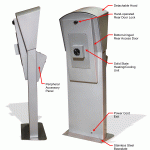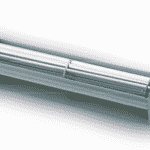Kiosk Cooling Considerations
Enclosure cooling overview of best practices including air conditioners, heat exchangers, fans and blowers. Applies to NEMA 12,4 & 4X . Open and closed loop.
Early Planning Helps Avoid Problems Later!
Heat producing components currently used in electronic and industrial equipment enclosures present the problem of dissipating the heat generated before damage can occur to heat-sensitive parts. In many cases, the problem can be solved by ventilation, using simple air moving devices such as Fans and Blowers. However, in an increasing amount of applications, the available ambient air is contaminated or too warm to be used for the safe dissipation of the unwanted heat. Under these conditions, the life expectancy and performance of sensitive components may be adversely impacted, often causing equipment malfunctions, slowdowns or failures. For such applications, where ambient air cannot be used, a Heat Exchanger or Air Conditioner is the best choice.
In order to create the optimum environment for the application, an evaluation of the anticipated operating conditions and thermal requirements of the equipment (or system) must be completed.
Here are some good questions to ask:
- Does the equipment/system require cooling, or is spot cooling adequate?
- Are there any components that are particularly sensitive to heat or other adverse conditions?
- How much heat is produced within the enclosure?
- What is the maximum temperature acceptable in the enclosure?
- What is the average and maximum temperature range of the ambient air?
- Is a specifically maintained temperature range required?
- What is the particulate and moisture content of the ambient air?
- Does the ambient air contain dirt, oil, corrosives or other contaminants harmful to enclosure contents?
- Where can cooling devices be mounted on the enclosure?
- Do the contents inside the enclosure need to be isolated (by the use of a sealed enclosure) from the heat or contaminants in the ambient air?
After all of the application-specific factors are determined, a decision can be made about the type of ventilation or cooling required, and which equipment provides the most appropriate performance and cost-effective solution. A little time and effort spent early in the design process to choose the optimum cooling equipment can save a lot of trouble and expense later, as this would prevent the need to retrofit with proper cooling devices in the field.
FANS: Fans occupy minimal cabinet space and will move a substantial volume of air where flow is virtually unimpeded. Packaged fans can be used for filtered panel or rack-mounted cooling in such applications.
BLOWERS: Blowers are designed to operate against higher static pressures. Packaged blowers provide compact, filtered, rack-mounted cooling in a variety of airflow configurations.
HEAT EXCHANGERS AND AIR CONDITIONERS: In applications where equipment operating temperatures must remain near or below ambient, or where airborne contaminants pose a threat to electronic components, the enclosure interior must be isolated from the external environment. For such applications, a sealed enclosure, with a Heat Exchanger or Air Conditioner is required. Heat Exchangers are recommended for equipment which can tolerate operating temperatures moderately higher than ambient, while Air Conditioners are required where equipment temperatures must be maintained at or below ambient.
Source: blog.kooltronic.com
From our page
Outdoor Heating and Cooling
Integrating the correct HVAC unit maintains the optimal temperature and humidity level within the kiosk, for peak reliability. Your provider will consult with deployers on the operational environment, making recommendations for the best cost/performance selection. Outdoor-Sizing Guide and also Outdoor-eic_understanding_heatload_ebook are useful for determining how much cooling or heating is needed. TECA Cooling is a member of the Industry Group and is highly skilled in cooling. Kooltronic has a nice sizing tool as well.
Outdoor kiosk example Example of rear mounted thermo or Peltier cooler. Click for full image
The standard units are compressor-based. Heating and cooling options include thermocouples which are smaller than compressors but also more money for less cooling..
Consider the environment. Even in a closed system there will be exposure to outside air. And the kiosk enclosure itself. Is it salty? If so you might consider stainless steel. Another option is zinc-rich primer powdercoat as well as G90 Electroplated.
Choose components wisely and engineer design your unit to maximize natural cooling and heating and you can often eliminate or at least mitigate required A/C and heating requirements.
Another heat consideration is direct sunlight in a warm climate (we are thinking Arizona, Dallas or Florida). Here is fan flow device from Panel-Brite which is a fan for cooling the touchscreen. Ventilation and smart design cannot be stressed enough.
From Panel-Brite:
Using touch screens of any kind in extremely hot temperatures usually requires extra airflow to move super-hot air out of the gap between the front of the panel and back of the touch screen.
For these types of outdoor applications, the air gap should be increased using thicker foam tape when mounting the touch screen to the panel. This gap should certainly be more than what is used for indoor applications.
A locale such as Los Angeles is not as severe as a low humidity state which surprises people
Typically units will come with air filters. They need to be maintained. Don’t adequately filter and you can end up with “isotropic” screens such as McDonalds and Samsung demonstrated. See Updated McDonalds Menu boards Failures – sometimes it is as simple as NOT changing a filter







